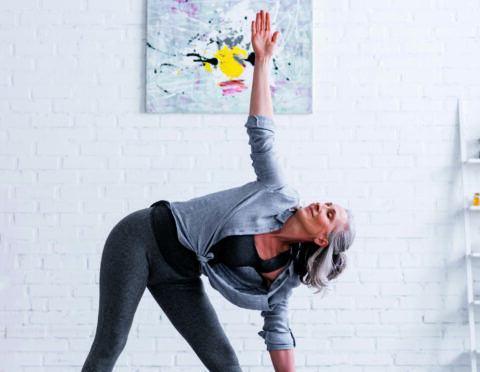
The tinkling of calming, music plays while the scent of soothing essential oils floats through the air and, despite the peaceful setting, my body is in duress.
I am trying my best to hold a downward dog position for as long as possible before my knees start to shake and buckle, but for a habitual yoga-goer like me, the session so far consists of pretty standard stuff – nothing I have not wobbled through before.
Yet the class, led by experienced yogi and author Karen Kirkness in Edinburgh’s trendy Meadowlark Yoga Studio, turns out to have a literal twist.
I am at a launch event for Kirkness’ new book, Spiral Bound: Integrated Anatomy For Yoga, which examines how our movement is determined by the body’s anatomical structure, and how good yoga practice can maintain the body’s flexibility and joint health over time.
Kirkness insists that if we understand how our body is naturally built to move; the less likely we are to push it past its limits.
That means less joint pain, pulled muscles and sports injuries, and more mobility and flexibility for years into the future.
In a move I have never been asked to try in a yoga session before, Kirkness asks us to turn and adjust our hands while in the downward dog position so that they are twisting in towards our bodies, rather than outwards.
It is unusual and feels slightly ridiculous, but after a few seconds, I feel the satisfying pull of a muscle in the midst of a much-needed stretch.
For the rest of the class, Kirkness introduces twists and rotational adjustments to ensure our bodies are flowing the way they should. “I want to teach people that they can heal their own bodies,” explains Kirkness to the class.
It is a statement that sounds more out there than it actually is. If you understand the anatomy of your body, you are better able to correct bad practices in your exercise regimes, or even in daily life.
Instructors on why yoga’s appeal keeps growing as restrictions loosen
For example, you will naturally adjust how you lift weights to lessen the likelihood of injury, and will instinctively know what type of stretch is best after a long day sitting immobile at your desk.
You will know better than to repeatedly put strain on a small injury so that it does not grow into a bigger injury, and you will not have to rely on physiotherapists and masseuses to soothe your aches and pains.
Kirkness argues that people should put gentleness and moderation at the heart of their approach to yoga, but many online videos and photos show young people pushing their bodies into extreme shapes and poses.
This can put potential yogis off the practise, especially older people who do not believe their bodies are flexible enough to get full use out of a yoga class. Kirkness explained that such shapes are unrealistic and potentially dangerous, even for people who make it look easy.
“I used to have an addiction to intensity, and treating yoga like an endurance sport. You can get really intoxicated by the beautiful shapes you see people put their bodies into on TikTok and Instagram.
Over time, I learned you either have to do things really gradually while being mindful of the rotational shapes in the body, or you end up injuring yourself. My hope is that people will appreciate that you can’t just throw yourself into these shapes.”
Kirkness’ masters degree was in anatomy, and she was fascinated with why flexibility came so easily to some people but was so difficult for others.
She studied the structure of the body and how it moves, and realised that movement is rotational in nature.
When we pick something up or turn to walk in a new direction, we do not move like stuttering robots, we twist and flow.
Yet modern day exercise regimes do not seem to take that into consideration, with many gym goers splitting the body into different sections and only working one part at a time.
Kirkness explained: “We want to shift out of developing one muscle to the exclusion of all your other.
“We want to move towards whole body rotational movement so that everything inside is spiralling and gliding.
“That spiral motion keeps the joint surfaces healthy, and so reduces inflammation of joints.
“The chemical balance of the joints change as we age, and the body tends toward inflammation with our quite sedentary lifestyles and modern diet full of things like sugar, alcohol and coffee.
“But if we change our diet and become more aware of the way we move, and allow the joints to spiral and glide, we should be able to prolong our lives and feel good in our bodies for longer.
“Yoga is an excellent practice for protecting your joints and keeping them healthy for years to come when done properly.”
“I hope the book encourages people to look beyond a pre-defined physical goal like chin ups or developing the perfect golf swing, and instead change the way they move and train to focus more on an overall performance goal that keeps the joints healthy.
“I feel like people are comfortable with reading about fitness, but do not feel comfortable about going out there and doing it, and moving their bodies.
“It is never too late to get started, and even just getting on the floor for some floor-based movement, is a huge achievement.
“There is now a form of chair yoga that helps maintain the health of the joints, so there is really no excuse – it is a case of learning what works best for you and getting started.”
Spiral Bound: Integrated Anatomy For Yoga, Handspring Publishing, out now

Enjoy the convenience of having The Sunday Post delivered as a digital ePaper straight to your smartphone, tablet or computer.
Subscribe for only £5.49 a month and enjoy all the benefits of the printed paper as a digital replica.
Subscribe